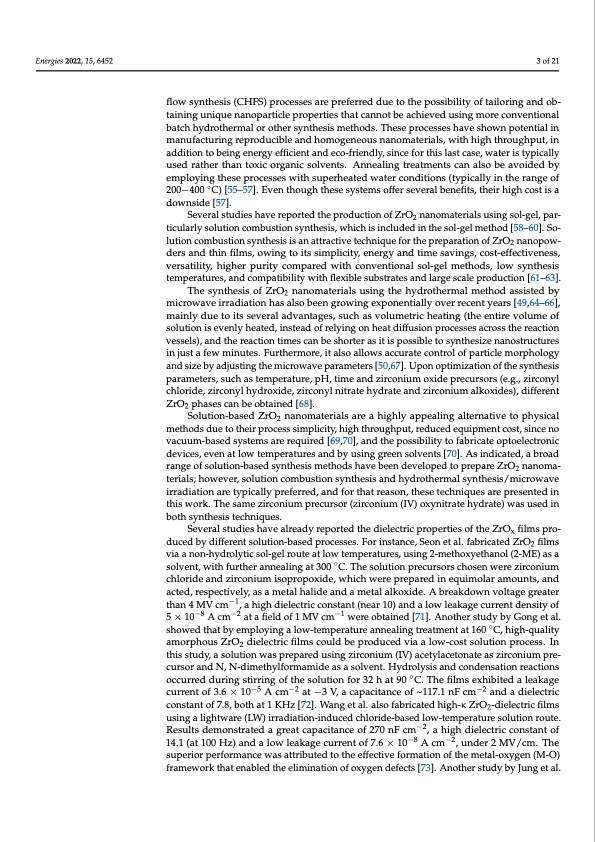
PDF Publication Title:
Text from PDF Page: 003
Energies 2022, 15, 6452 3 of 21 flow synthesis (CHFS) processes are preferred due to the possibility of tailoring and ob- taining unique nanoparticle properties that cannot be achieved using more conventional batch hydrothermal or other synthesis methods. These processes have shown potential in manufacturing reproducible and homogeneous nanomaterials, with high throughput, in addition to being energy efficient and eco-friendly, since for this last case, water is typically used rather than toxic organic solvents. Annealing treatments can also be avoided by employing these processes with superheated water conditions (typically in the range of 200−400 ◦C) [55–57]. Even though these systems offer several benefits, their high cost is a downside [57]. Several studies have reported the production of ZrO2 nanomaterials using sol-gel, par- ticularly solution combustion synthesis, which is included in the sol-gel method [58–60]. So- lution combustion synthesis is an attractive technique for the preparation of ZrO2 nanopow- ders and thin films, owing to its simplicity, energy and time savings, cost-effectiveness, versatility, higher purity compared with conventional sol-gel methods, low synthesis temperatures, and compatibility with flexible substrates and large scale production [61–63]. The synthesis of ZrO2 nanomaterials using the hydrothermal method assisted by microwave irradiation has also been growing exponentially over recent years [49,64–66], mainly due to its several advantages, such as volumetric heating (the entire volume of solution is evenly heated, instead of relying on heat diffusion processes across the reaction vessels), and the reaction times can be shorter as it is possible to synthesize nanostructures in just a few minutes. Furthermore, it also allows accurate control of particle morphology and size by adjusting the microwave parameters [50,67]. Upon optimization of the synthesis parameters, such as temperature, pH, time and zirconium oxide precursors (e.g., zirconyl chloride, zirconyl hydroxide, zirconyl nitrate hydrate and zirconium alkoxides), different ZrO2 phases can be obtained [68]. Solution-based ZrO2 nanomaterials are a highly appealing alternative to physical methods due to their process simplicity, high throughput, reduced equipment cost, since no vacuum-based systems are required [69,70], and the possibility to fabricate optoelectronic devices, even at low temperatures and by using green solvents [70]. As indicated, a broad range of solution-based synthesis methods have been developed to prepare ZrO2 nanoma- terials; however, solution combustion synthesis and hydrothermal synthesis/microwave irradiation are typically preferred, and for that reason, these techniques are presented in this work. The same zirconium precursor (zirconium (IV) oxynitrate hydrate) was used in both synthesis techniques. Several studies have already reported the dielectric properties of the ZrOx films pro- duced by different solution-based processes. For instance, Seon et al. fabricated ZrO2 films via a non-hydrolytic sol-gel route at low temperatures, using 2-methoxyethanol (2-ME) as a solvent, with further annealing at 300 ◦C. The solution precursors chosen were zirconium chloride and zirconium isopropoxide, which were prepared in equimolar amounts, and acted, respectively, as a metal halide and a metal alkoxide. A breakdown voltage greater than 4 MV cm−1, a high dielectric constant (near 10) and a low leakage current density of 5 × 10−8 A cm−2 at a field of 1 MV cm−1 were obtained [71]. Another study by Gong et al. showed that by employing a low-temperature annealing treatment at 160 ◦C, high-quality amorphous ZrO2 dielectric films could be produced via a low-cost solution process. In this study, a solution was prepared using zirconium (IV) acetylacetonate as zirconium pre- cursor and N, N-dimethylformamide as a solvent. Hydrolysis and condensation reactions occurred during stirring of the solution for 32 h at 90 ◦C. The films exhibited a leakage current of 3.6 × 10−5 A cm−2 at −3 V, a capacitance of ~117.1 nF cm−2 and a dielectric constant of 7.8, both at 1 KHz [72]. Wang et al. also fabricated high-κ ZrO2-dielectric films using a lightware (LW) irradiation-induced chloride-based low-temperature solution route. Results demonstrated a great capacitance of 270 nF cm−2, a high dielectric constant of 14.1 (at 100 Hz) and a low leakage current of 7.6 × 10−8 A cm−2, under 2 MV/cm. The superior performance was attributed to the effective formation of the metal-oxygen (M-O) framework that enabled the elimination of oxygen defects [73]. Another study by Jung et al.PDF Image | Comparison between Solution-Based Synthesis Methods of ZrO2

PDF Search Title:
Comparison between Solution-Based Synthesis Methods of ZrO2Original File Name Searched:
energies-15-06452.pdfDIY PDF Search: Google It | Yahoo | Bing
Turbine and System Plans CAD CAM: Special for this month, any plans are $10,000 for complete Cad/Cam blueprints. License is for one build. Try before you buy a production license. More Info
Waste Heat Power Technology: Organic Rankine Cycle uses waste heat to make electricity, shaft horsepower and cooling. More Info
All Turbine and System Products: Infinity Turbine ORD systems, turbine generator sets, build plans and more to use your waste heat from 30C to 100C. More Info
CO2 Phase Change Demonstrator: CO2 goes supercritical at 30 C. This is a experimental platform which you can use to demonstrate phase change with low heat. Includes integration area for small CO2 turbine, static generator, and more. This can also be used for a GTL Gas to Liquids experimental platform. More Info
Introducing the Infinity Turbine Products Infinity Turbine develops and builds systems for making power from waste heat. It also is working on innovative strategies for storing, making, and deploying energy. More Info
Need Strategy? Use our Consulting and analyst services Infinity Turbine LLC is pleased to announce its consulting and analyst services. We have worked in the renewable energy industry as a researcher, developing sales and markets, along with may inventions and innovations. More Info
Made in USA with Global Energy Millennial Web Engine These pages were made with the Global Energy Web PDF Engine using Filemaker (Claris) software.
Sand Battery Sand and Paraffin for TES Thermo Energy Storage More Info
| CONTACT TEL: 608-238-6001 Email: greg@infinityturbine.com | RSS | AMP |